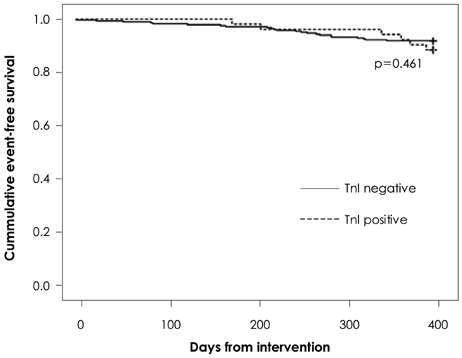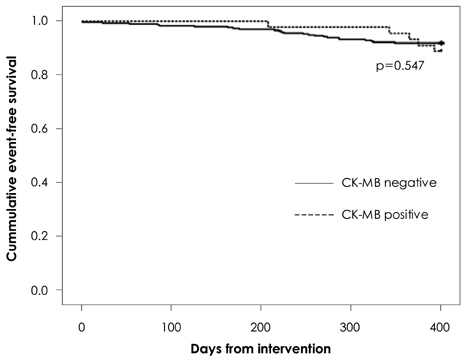Korean Circ J.
2008 Jan;38(1):12-16. 10.4070/kcj.2008.38.1.12.
Elevated Troponin I after Implantation of Drug-Eluting Stents: Incidence, Predictors, and Prognostic Value
- Affiliations
-
- 1Division of Cardiology, Department of Internal Medicine, The Catholic University of Korea College of Medicine, Seoul, Korea. kbseung@catholic.ac.kr
- KMID: 2225868
- DOI: http://doi.org/10.4070/kcj.2008.38.1.12
Abstract
- BACKGROUND AND OBJECTIVES
The presence of elevated troponin after percutaneous coronary intervention (PCI) is considered to reflect irreversible myocardial injury. However, its prognostic value remains unclear. The purpose of this study was to investigate the incidence, risk factors, and clinical outcomes of troponin I (TnI) elevation after the implantation of drug-eluting stent (DES).
SUBJECTS AND METHODS
We performed a retrospective analysis of 335 patients who had undergone PCI with DES. Patients who had acute coronary syndrome with elevated TnI levels before PCI were excluded. TnI levels were measured 6 and 24 hours after PCI. RESULTS: Baseline clinical characteristics were similar in the elevated TnI and normal TnI groups. Elevated postprocedural TnI (>1.5 ng/mL) occurred in 52 patients (15.5%). Univariate analysis revealed that the clinically significant variables were multi-vessel disease (p<0.001), multiple stent implantation (p=0.003), total stent length (p=0.001), side-branch occlusion (p<0.001), and bifurcation lesion (p=0.003). Multivariate analysis indicated that the independent predictors of elevated TnI after DES implantation were multi-vessel disease (p=0.019), side-branch occlusion (p=0.001), and bifurcation (p=0.011). There were no significant differences in major adverse cardiovascular events between the elevated TnI and normal TnI groups (p=0.461).
CONCLUSION
Multi-vessel disease, side-branch occlusion, and bifurcation were independent predictors of elevated TnI following DES implantation. The elevation of TnI after successful PCI with DES was not associated with worse 400-day clinical outcomes.
MeSH Terms
Figure
Reference
-
1. Selvanayagam JB, Porto I, Channon K, et al. Troponin elevation after percutaneous coronary intervention directly represents the extent of irreversible myocardial injury: insights from cardiovascular magnetic resonance imaging. Circulation. 2005. 111:1027–1032.2. Ricciardi MJ, Wu E, Davidson CJ, et al. Visualization of discrete microinfarction after percutaneous coronary intervention associated with mild creatine kinase-MB elevation. Circulation. 2001. 103:2780–2783.3. Mehran R, Dangas G, Mintz GS, et al. Atherosclerotic plaque burden and CK-MB enzyme elevation after coronary interventions: intravascular ultrasound study of 2256 patients. Circulation. 2000. 101:604–610.4. Califf RM, Abdelmeguid AE, Kuntz RE, et al. Myonecrosis after revascularization procedures. J Am Coll Cardiol. 1998. 31:241–251.5. Kim JH, Jeong MH, Sim DS, et al. The usefulness of cardiac troponin as a marker for the detection of minor myocardial injury following percutaneous coronary intervention. Korean Circ J. 2002. 32:413–419.6. Cho BR, Hong KP, Gwon HC, et al. Impact on long-term adverse cardiac events of troponin T or creatine kinase-MB release after percutaneous transluminal coronary angiography. Korean Circ J. 2002. 32:949–957.7. Segev A, Goldman LE, Cantor WJ, et al. Elevated troponin-I after percutaneous coronary interventions: incidence and risk factors. Cardiovasc Radiat Med. 2004. 5:59–63.8. Mandadi VR, DeVoe MC, Ambrose JA, et al. Predictors of troponin elevation after percutaneous coronary intervention. Am J Cardiol. 2004. 93:747–750.9. Stone GW, Mehran R, Dangas G, Lansky AJ, Kornowski R, Leon MB. Differential impact on survival of electrocardiographic Q-wave versus enzymatic myocardial infarction after percutaneous intervention: a device-specific analysis of 7147 patients. Circulation. 2001. 104:642–647.10. Brener SJ, Ellis SG, Schneider J, Topol EJ. Frequency and longterm impact of myonecrosis after coronary stenting. Eur Heart J. 2002. 23:869–876.11. Ellis SG, Chew D, Chan A, Whitlow PL, Schneider JP, Topol EJ. Death following creatine kinase-MB elevation after coronary intervention: identification of an early risk period: importance of creatine kinase-MB level, completeness of revascularization, ventricular function, and probable benefit of statin therapy. Circulation. 2002. 106:1205–1210.12. Saucedo JF, Mehran R, Dangas G, et al. Long-term clinical events following creatine kinase: myocardial band isoenzyme elevation after successful coronary stenting. J Am Coll Cardiol. 2000. 35:1134–1141.13. Tardiff BE, Califf RM, Tcheng JE, et al. Clinical outcomes after detection of elevated cardiac enzymes in patients undergoing percutaneous intervention. J Am Coll Cardiol. 1999. 33:88–96.14. Kornowski R, Fuchs S, Hong MK, et al. Prognostic value of recurrent episodes of creatine kinase-MB elevation following repeated catheter-based coronary interventions. Catheter Cardiovasc Interv. 2000. 51:131–137.15. Cavallini C, Savonitto S, Violini R, et al. Impact of the elevation of biochemical markers of myocardial damage on long-term mortality after percutaneous coronary intervention. Eur Heart J. 2005. 26:1494–1498.16. Kini AS, Lee P, Marmur JD, et al. Correlation of postpercutaneous coronary intervention creatine kinase-MB and troponin I elevation in predicting mid-term mortality. Am J Cardiol. 2004. 93:18–23.17. Bertinchant JP, Polge A, Ledermann B, et al. Relation of minor cardiac troponin I elevation to late cardiac events after uncomplicated elective successful percutaneous transluminal coronary angioplasty for angina pectoris. Am J Cardiol. 1999. 84:51–57.18. Wu AH, Boden WE, McKay RG. Long-term follow-up of patients with increased cardiac troponin concentrations following percutaneous coronary intervention. Am J Cardiol. 2002. 89:1300–1302.19. Ramirez-Moreno A, Cardenal R, Pera C, et al. Predictors and prognostic value of myocardial injury following stent implantation. Int J Cardiol. 2004. 97:193–198.20. Gruberg L, Fuchs S, Waksman R, et al. Prognostic value of cardiac troponin I elevation after percutaneous coronary intervention in patients with chronic renal insufficiency: a 12-month outcome analysis. Catheter Cardiovasc Interv. 2002. 55:174–179.21. Cantor WJ, Newby LK, Christenson RH, et al. Prognostic significance of elevated troponin I after percutaneous coronary intervention. J Am Coll Cardiol. 2002. 39:1738–1744.22. Nallamothu BK, Chetcuti S, Mukherjee D, et al. Prognostic implication of troponin I elevation after percutaneous coronary intervention. Am J Cardiol. 2003. 91:1272–1274.23. Natarajan MK, Kreatsoulas C, Velianou JL, Mehta SR, Pericak D, Goodhart DM. Incidence, predictors, and clinical significance of troponin-I elevation without creatine kinase elevation following percutaneous coronary interventions. Am J Cardiol. 2004. 93:750–753.24. Garbarz E, Iung B, Lefevre G, et al. Frequency and prognostic value of cardiac troponin I elevation after coronary stenting. Am J Cardiol. 1999. 84:515–518.25. Fuchs S, Kornowski R, Mehran R, et al. Prognostic value of cardiac troponin-I levels following catheter-based coronary interventions. Am J Cardiol. 2000. 85:1077–1082.26. Ricciardi MJ, Davidson CJ, Gubernikoff G, et al. Troponin I elevation and cardiac events after percutaneous coronary intervention. Am Heart J. 2003. 145:522–528.
- Full Text Links
- Actions
-
Cited
- CITED
-
- Close
- Share
- Similar articles
-
- Systemic drug therapy and restenosis after drug-eluting stent implantation
- A Case of Stent Thrombosis Occurred at 5 Years after Sirolimus-Eluting Stent Implantation
- A Case of Stent Strut Fracture of a Paclitaxel-Eluting Stent at the Time of Stent Implantation in a Complex Coronary Lesion
- Very Late Stent Thrombosis Related to Fracture of a Sirolimus-Eluting Stent
- A Case of a Zotarolimus-Eluting Stent Fracture in the Left Anterior Descending Artery in a Patient Undergoing Hemodialysis



